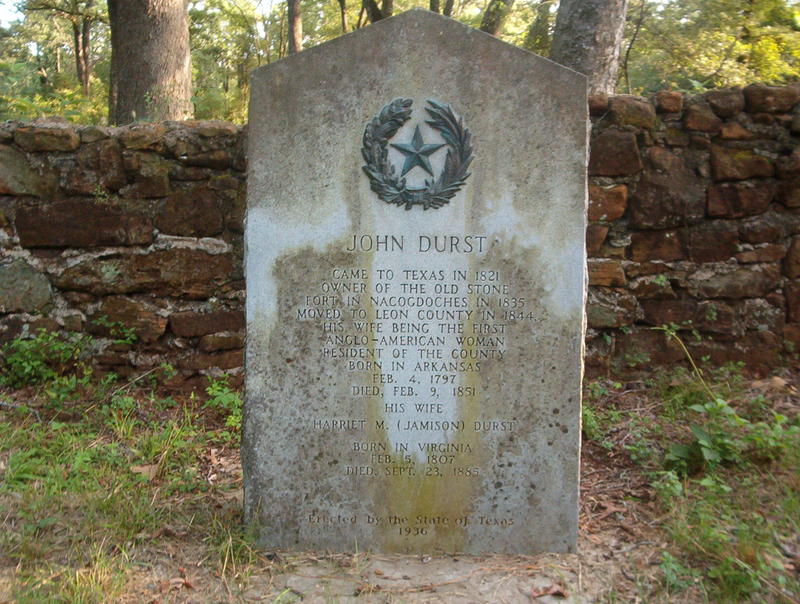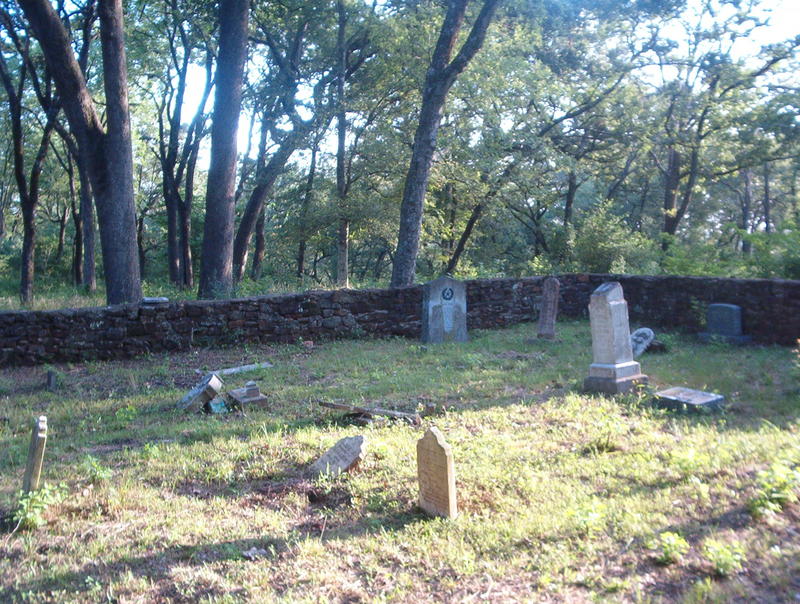JOHN MARIE DURST
John Marie Durst, early East Texas merchant and patriot, sometimes called the Paul Revere of the Texas Revolution, was born on February 4, 1797, at Arkansas Post, Arkansas, the son of Jacob and Anna Agnes (Schesser) Durst. Two years later his mother died, leaving Jacob Durst with eight children to raise. In 1803 the family moved to Natchitoches, Louisiana; then in 1806 Jacob and three of his sons, including John M., went to Texas. John, only nine years of age, was taken into the home of his godfather, P. Samuel Davenport, a prominent Nacogdoches merchant who was appointed his guardian after his father's death in 1814. Davenport taught Durst to manage a mercantile firm and to speak several languages, especially Spanish and Cherokee. After the Gutiérrez-Magee expedition, Durst accompanied his exiled godfather to Natchitoches. Soon thereafter, at the age of seventeen, he volunteered for military service in the Second Louisiana Division. He participated in the last years of the War of 1812 (1814-15) and returned to Natchitoches at its end. While living in Natchitoches, Durst became acquainted with Maj. John Jamison, the Indian agent at Fort Jesup, and on February 15, 1821, he married Jamison's young daughter, Harriet Matilda. They had twelve children, six of whom survived to adulthood. They employed John H. Reagan as a tutor for four years. In his will, dated 1824, Samuel Davenport bequeathed 10,000 acres of land in western Louisiana to Durst. In November 1829 as the result of an agreement with Davenport's son Juan Benigno, Durst acquired all Davenport's land titles west of the Sabine River in exchange for Durst's land titles east of the river. In April 1834 Durst received a Mexican land grant of five leagues in Houston, Nacogdoches, and Anderson counties. By 1837 the tax roll for Nacogdoches County listed him as the owner of 36,200 acres of Texas land.
By 1829 he had returned to Nacogdoches, where he established a mercantile business, became active in local politics, and was in great demand as an interpreter of Spanish, French, German, and a number of Indian languages. From 1829 until July 1834 he and his family lived in the Old Stone Fort. In 1832 he took part in the battle of Nacogdoches. Durst served as an interpreter for the Mexican government in its negotiations with the Indians. In 1834 he moved to his San Patricio grant on the Angelina River, where he laid out the town of Mount Sterling.
In 1835 Durst was serving as a Texas representative in the legislature of the Mexican state of Coahuila and Texas. While there he learned from Mexican friends of the impending movement into Texas of the forces of Antonio López de Santa Anna. Thereupon Durst rode 960 miles to warn the people of Texas. The ride earned him his Paul Revere sobriquet. During the revolution Durst commanded a company on the east bank of the Angelina River and reported the activities of Col. Galerno Cruz below Nacogdoches. Durst was also captain of a company operating with Thomas J. Rusk against the Kickapoo Indians and against Chief Bowl and the Cherokees. In 1844 he moved to Sterling C. Robertson's colony in what later became Leon County, where he bought land near Leon Prairie. In 1846 he was an agent to receive government supplies for United States troops en route to Mexico. Durst died in Galveston on February 9, 1851, while attending a session of the Texas Supreme Court. He was buried in the family cemetery on his homestead near Leona in Leon County. His wife died in Leon County on September 23, 1885, and was also buried in the family cemetery. In 1936 the state of Texas erected a monument to John M. and Harriet Matilda Durst in the family cemetery in Leon County.
JOHN MARIE DURST
John Marie Durst, early East Texas merchant and patriot, sometimes called the Paul Revere of the Texas Revolution, was born on February 4, 1797, at Arkansas Post, Arkansas, the son of Jacob and Anna Agnes (Schesser) Durst. Two years later his mother died, leaving Jacob Durst with eight children to raise. In 1803 the family moved to Natchitoches, Louisiana; then in 1806 Jacob and three of his sons, including John M., went to Texas. John, only nine years of age, was taken into the home of his godfather, P. Samuel Davenport, a prominent Nacogdoches merchant who was appointed his guardian after his father's death in 1814. Davenport taught Durst to manage a mercantile firm and to speak several languages, especially Spanish and Cherokee. After the Gutiérrez-Magee expedition, Durst accompanied his exiled godfather to Natchitoches. Soon thereafter, at the age of seventeen, he volunteered for military service in the Second Louisiana Division. He participated in the last years of the War of 1812 (1814-15) and returned to Natchitoches at its end. While living in Natchitoches, Durst became acquainted with Maj. John Jamison, the Indian agent at Fort Jesup, and on February 15, 1821, he married Jamison's young daughter, Harriet Matilda. They had twelve children, six of whom survived to adulthood. They employed John H. Reagan as a tutor for four years. In his will, dated 1824, Samuel Davenport bequeathed 10,000 acres of land in western Louisiana to Durst. In November 1829 as the result of an agreement with Davenport's son Juan Benigno, Durst acquired all Davenport's land titles west of the Sabine River in exchange for Durst's land titles east of the river. In April 1834 Durst received a Mexican land grant of five leagues in Houston, Nacogdoches, and Anderson counties. By 1837 the tax roll for Nacogdoches County listed him as the owner of 36,200 acres of Texas land.
By 1829 he had returned to Nacogdoches, where he established a mercantile business, became active in local politics, and was in great demand as an interpreter of Spanish, French, German, and a number of Indian languages. From 1829 until July 1834 he and his family lived in the Old Stone Fort. In 1832 he took part in the battle of Nacogdoches. Durst served as an interpreter for the Mexican government in its negotiations with the Indians. In 1834 he moved to his San Patricio grant on the Angelina River, where he laid out the town of Mount Sterling.
In 1835 Durst was serving as a Texas representative in the legislature of the Mexican state of Coahuila and Texas. While there he learned from Mexican friends of the impending movement into Texas of the forces of Antonio López de Santa Anna. Thereupon Durst rode 960 miles to warn the people of Texas. The ride earned him his Paul Revere sobriquet. During the revolution Durst commanded a company on the east bank of the Angelina River and reported the activities of Col. Galerno Cruz below Nacogdoches. Durst was also captain of a company operating with Thomas J. Rusk against the Kickapoo Indians and against Chief Bowl and the Cherokees. In 1844 he moved to Sterling C. Robertson's colony in what later became Leon County, where he bought land near Leon Prairie. In 1846 he was an agent to receive government supplies for United States troops en route to Mexico. Durst died in Galveston on February 9, 1851, while attending a session of the Texas Supreme Court. He was buried in the family cemetery on his homestead near Leona in Leon County. His wife died in Leon County on September 23, 1885, and was also buried in the family cemetery. In 1936 the state of Texas erected a monument to John M. and Harriet Matilda Durst in the family cemetery in Leon County.
Inscription
FAREWELL
To the memory of
JOHN DURST
DIED
Feby. 9, 1851,
AGED
54 years
_________
[Inscription]
Gravesite Details
1C5R
Family Members
-
![]()
Louis Orlando Durst
1827–1859
-
![]()
Mary Benigna Durst Blake
1830–1864
-
![]()
Charles Placide "Bruno" Durst
1832–1905
-
Alexander H. Durst
1834–1840
-
Angelina Anna Durst
1837–1841
-
![]()
Harriet Matilda Durst Hopkins
1839–1871
-
![]()
Rev John Sterling Durst
1841–1924
-
![]()
Horatio Walter "Rashe" Durst
1844–1930
-
![]()
Clara Elizabeth Durst
1846–1856
-
![]()
Eugene Marcelino Durst
1849–1849



















